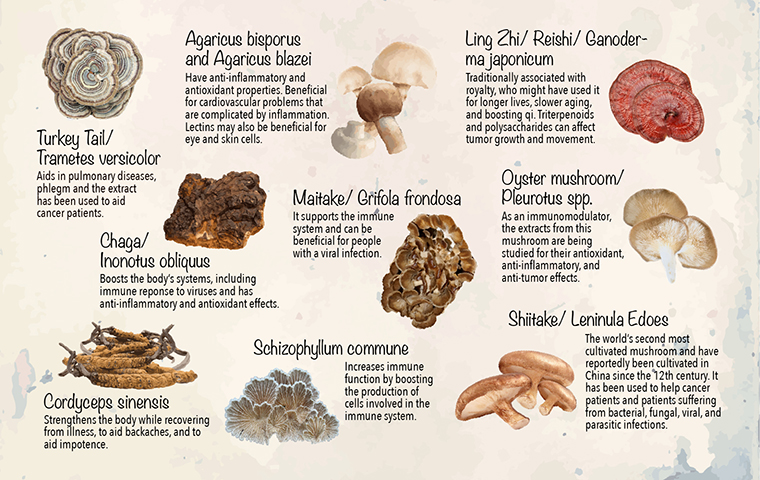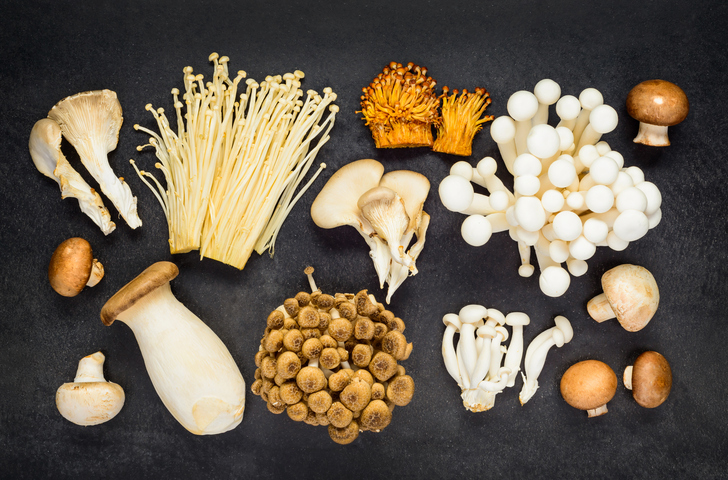What are Medicinal Mushrooms?
There are 22,000 known species of mushrooms on earth, but it is estimated that this only represents 10% of the mushroom species. That means over 110,000 species of mushrooms haven’t been identified (i). About 7,000 species are considered to be edible, and 700 are considered to have pharmacological properties (ii).
Mushrooms are a good source of vitamins and minerals. Eating mushrooms can help you get enough Vitamin D, potassium, and copper. This is the only produce that contains a significant amount of selenium (iii). Selenium is needed for reproduction, thyroid hormone metabolism, making DNA, and protecting against infection and oxidative damage (xxiii). For vegetarians, mushrooms are a great way to get Vitamin B12, which is often obtained through meat (iii). Vitamin B12 is necessary for protein metabolism, making red blood cells, and maintaining the central nervous system (xxiv). They also are low in fat and cholesterol-free (iii). They are a good source of carbohydrates, dietary fiber, and amino acids. The polysaccharides are prebiotics and promote the growth of healthy bacterial intestinal flora. These are also helpful for reducing total and LDL cholesterol (iv).
Medicinal mushrooms have been used for thousands of years in traditional Chinese medicine (TCM) (v). Their primary use was for aiding the immune system, whether that was due to a parasitic, viral, bacterial, or fungal infection. Additionally, they were used to promote heart and liver health (vi).
Incorporating medicinal mushrooms into your diet can be done in a variety of ways. They can be sautéed in olive oil or grapeseed oil. Grilling mushrooms is another popular choice. Stir-frying or simmering mushrooms in a broth can be an easy way to eat your mushrooms with other vegetables. (iii). Blanching mushrooms may reduce some of the active compounds (iv). Additionally, extracts of mushrooms are sold as a concentrated powder. These powders may be used to make a tablet or capsule.
Biohacking and Medicinal Mushrooms
Biohacking is essentially do-it-yourself biology. It can involve genetic testing experiments and tests for how to grow better plants or changing an amoeba to glow-in-the-dark. One common form of biohacking is making lifestyle changes to control the systems in your own body (viii). This can involve anything from nutritional changes to genetic sequencing. You may have already done some biohacking without realizing it. With smartwatches, it’s easy to track activity and sleep levels. Based on the data gathered from the device, you can see how your day-to-day activities affect how you feel. Then you can make changes to improve your physical and mental health (viii).
There are easy and inexpensive ways to begin biohacking for yourself. One simple change is improving your posture. Many of us spend lots of time sitting, and poor posture can lead to chronic injuries and future pain. By keeping your spine in a neutral position (ears in line with shoulders), you can help prevent pain. Incorporating stretching as a daily habit and using a foam roller can help alleviate tension, as well (viii). Meditating has been linked with numerous positive benefits including reducing pain and inflammation and improving sleep quality and productivity. Whether this is through a religious prayer service or through an app for guided meditation, taking time out of the day for stillness and meditation can improve your mental health (ix).
What you eat provides fuel for all of your body systems, so it’s natural for diet to be emphasized in biohacking. Functional foods are simply foods that affect a body function positively. Biohackers incorporate them into diet to aid their body systems. Mushrooms have been used both for taste and function for thousands of years (i). At a biohacker conference, mushroom coffee was available, so people could enjoy the benefits of mushrooms in a hot drink. They advertised it as boosting the immune system, fighting obesity, improving good gut bacteria, improving mental focus, and boosting energy. People said that it looked like coffee but tasted like tea (x). Pharmaceuticals are taking note of how mushrooms can benefit the body, and these companies are researching the ways mushroom extracts can improve health (x). Like other forms of biohacking, it may be helpful to track how you feel after eating new foods.
Potential Anti-Cancer Effects
The compounds within mushrooms can stimulate the immune system. Activating the immune system leads to increased immune response, and this may be helpful for cancer patients (i). For patients undergoing chemotherapy, mushrooms can aid their weakened immune function (xi).

Maitake / Grifola frondosa
Maitake is also called “hen of the woods”. It supports the immune system and can be beneficial for people with a viral infection (iii). Additionally, glycoprotein complexes in the mushroom are being studied for anti-tumor activity (i). In one research study, patients who received maitake extracts with their chemo had higher response rates to their chemo treatment (xii). If you’re looking for a fun way to cook maitake, It can be grilled with teriyaki sauce (iii).
Agaricus bisporus and Agaricus blazei
You may be more familiar with these as button mushrooms, which includes Portobello and Crimini (iii). Extracts from button mushrooms are being studied to aid cancer patients because of the immune stimulation effect (i). Lectins within button mushrooms are being studied for their potential inhibitory effect on breast cancer cells (iv).
There is also research being done to see how these extracts affect bacteria [i]. Button mushrooms also have anti-inflammatory and antioxidant properties. This can be beneficial for cardiovascular problems that are complicated by inflammation [iv]. Lectins may also be beneficial for eye and skin cells (iv). These are a good mushroom to eat to promote eye health, because they have carotenoids (just like carrots!)(iv).
Cordyceps sinensis
This mushroom is also called a caterpillar fungus. Its first recorded use was in 620 AD, during the Tang Dynasty [v]. It grows at high altitudes in the Himalayas. According to stories from the area, yak herders noticed a correlation between strong cattle and the presence of cordyceps mushrooms (xiii). For people, it has been used to strengthen the body while recovering from illness, to aid backaches, and to aid impotence. It is being studied as a way to aid cancer patients’ fatigue and weakness (v). In a study with mice, C. sinensis extracts led to increased immune response. One way it may help people overcome fatigue is by increasing blood flow to supply oxygen to organs. Extracts have also been studied as a way to inhibit lactic acid buildup to improve muscular endurance while exercising (xiv).
Immunomodulator
This suppression or enhancement of the immune system is called immunomodulation (v). Improving the immune system with mushroom extracts is being researched to help with infections.
Turkey Tail / Trametes versicolor
In TCM, it is called Yun Zhi, and in Japan, it is referred to as Kawaratake (xi). Turkey tail gets its name based on its resemblance to a turkey’s rear feathers (xiii). It has been used for pulmonary diseases, including problems with phlegm and the extract has been used to aid cancer patients (xi,xv). Polysaccharide-K (PSK) has been studied for decades in Japan as a way to boost the immune systems and improve survival among cancer patients while using traditional anticancer treatments (xi). In clinical studies, cancer patients taking PSK experienced reduced side effects from their chemo and enjoyed a greater quality of life (xvi). Turkey tail’s immunomodulation effects are also being studied to combat viruses (xiii).
Shiitake / Leninula edoes
These mushrooms are the world’s second most cultivated mushroom and have reportedly been cultivated in China since the 12th century (v,xv). It has been used to help cancer patients and patients suffering from bacterial, fungal, viral, and parasitic infections. Research on shiitake extracts has been done to see how the shiitake extract lentinan can be used against tuberculosis. In a research study with mice, some mice were injected with lentinan. These mice had reduced growth of the tuberculosis in the liver and spleen, and their immune systems were stimulated. This immune system stimulation may lead to a lower amount of the mycobacterium causing tuberculosis and lowers the overall mycobacterium load in the system (xvii).
Chaga / Inonotus obliquus
Chaga has been called “gift from god” in Siberia. It can be found in on trees in cold climates in Canada, Scandinavia, and Russia. Superoxide dismutase (SOD) boosts the body’s systems, including improving the immune response to viruses (xiii). Extracts from Chaga mushrooms are being studied for their ability to inhibit viral proteases (xiii). SOD also has anti-inflammatory and antioxidant effects, so this can be helpful for damaged cells (xiii).
Schizophyllum commune
This mushroom also increases immune function by boosting the production of cells involved in the immune system (i). Schizophyllan (SPG) is made from fermenting the mushroom and has been used as an immunomodulator. In Japan, SPG has been studied to see how it can aid patients with lung, cervical, and gastric cancers (xx) . Extracts of S. commune are also being studied for potential antimicrobial effects. In a study, these extracts inhibited the growth of some bacteria on an agar plate (xxi).
Ling Zhi / Reishi/ Ganoderma japonicum
In TCM, this mushroom is referred to as Ling Zhi, but Reishi refers to the same mushrooms in Japanese medicine(xi) . It can be found on hardwood trees in North and South American, Europe, and Asia (v). There are recordings of this mushroom being used in TCM in “Shen Nung Ben Cao Jing”, which was written between 206 BC and 8 AD. Because of its rarity in nature, it was traditionally associated with royalty, who might have used for longer lives, slower aging, and boosting qi. Triterpenoids and polysaccharides can affect tumor growth and movement (xi). In addition to being studied for use with cancer patients, it is also being studied for how it affects allergies, inflammation, bacteria, and pulmonary function (v).
Oyster mushroom / Pleurotus spp
As an immunomodulator, the extracts from this mushroom are being studied for their antioxidant, anti-inflammatory, and anti-tumor effects. These properties are attributed to the amino acids within the oyster mushroom. Research is being done to see how extracts of oyster mushrooms can be beneficial. Giving arginine supplements to cancer patients was linked to improved immune function, weight gain, and longer survival time (iv). In one research study, mice with Ehrlich’s ascites carcinoma (EAC) experienced a reduction in tumors [i]. Some of the flavonoid extracts, like chrysin, are being studied for potential neurological benefits. Chrysin is being studied as a compound that may protect neural tissues. This research is being used to potentially benefit people living with epilepsy, depression, amyloid build-up, and inflammation of the neural system (xix).
Safety and Other Considerations
Overall, adverse side effects for medicinal mushrooms are fairly rare. Medicinal mushrooms are not recommended for anyone who has experienced a previous allergic reaction to mushrooms. One example is shiitake dermatitis. The symptoms of this reaction are a light sensitive skin reaction (xxii)[xxii]. Some mushrooms may have a hypoglycemic effect (xii). Diabetics should be cautious and pay close attention to their blood sugar levels if adding considerably more mushrooms to their diet.
Research on how mushrooms affect the immune system is ongoing. Although there are studies supporting the use of mushrooms to aid the immune system, there is not enough evidence to completely stop using medications, like antibiotics, chemotherapy, antiviral medications, or tuberculosis drugs. Talk with your doctor if you are planning on altering your medication plan.
It is important to remember that there are poisonous mushrooms. For most consumers of whole mushrooms, the safest option is to purchase mushrooms from a farmer’s market or grocery store. Foraging can be dangerous, and you should only eat mushrooms that you can identify with 100% certainty. The North American Mycological Association tracks mushroom poisonings, and there is an average of a death per year from mushrooms (iii). Effects of mushroom poisonings can range from fatigue and gastrointestinal trouble to a slowed heart rate and hepatic disease (ii).
Like all foods, there can be too much of a good thing. Mushrooms contain agaritines, which are also found in French fries. These agaritines may increase the risk of tumors in animals, but there hasn’t been conclusive evidence that agaritines are harmful to people. Avoid eating large quantities of mushrooms. Cooking can be helpful with breaking down some of a mushroom’s naturally occurring toxins. Plus, this breaks down the tough cell walls and will help the digestive system to absorb all of the beneficial nutrients (iii).
References
[i] Ganeshpurkar, A., Rai, G., & Jain, A. P. (2010). Medicinal mushrooms: Towards a new horizon. Pharmacognosy Reviews, 4(8), 127–135. doi.org/10.4103/0973-7847.70904 [ii] Jo, W.-S., Hossain, M. A., & Park, S.-C. (2014). Toxicological Profiles of Poisonous, Edible, and Medicinal Mushrooms. Mycobiology, 42(3), 215–220. [iii] McMillen, M. (n.d.). Mushrooms: What’s Edible, Medicinal, and Psychedelic. Retrieved January 17, 2018, from www.webmd.com/food-recipes/features/types-of-mushrooms#1 [iv] Bożena Muszyńska, Agata Grzywacz-Kisielewska, Katarzyna Kała, Joanna Gdula-Argasińska, Anti-inflammatory properties of edible mushrooms: A review, Food Chemistry, Volume 243, 2018, Pages 373-381, ISSN 0308-8146, doi.org/10.1016/j.foodchem.2017.09.149. [v] Wong. (n.d.). Medicinal Mushroom? Retrieved January 17, 2018, from https://bit.ly/2NBSlWl [vi] Wasser, S. P. (2014). Medical Mushroom Science: Current Perspectives, Advances, Evidences, and Challenges. Biomed J, 37(6), 345-354. Retrieved January 17, 2018, from http://biomedj.cgu.edu.tw.proxy.library.emory.edu [iv] Bożena Muszyńska, Agata Grzywacz-Kisielewska, Katarzyna Kała, Joanna Gdula-Argasińska, Anti-inflammatory properties of edible mushrooms: A review, Food Chemistry, Volume 243, 2018, Pages 373-381, ISSN 0308-8146, doi.org/10.1016/j.foodchem.2017.09.149. [v] Wong. (n.d.). Medicinal Mushroom? Retrieved January 17, 2018, from https://bit.ly/2NBSlWl [vi] Wasser, S. P. (2014). Medical Mushroom Science: Current Perspectives, Advances, Evidences, and Challenges. Biomed J, 37(6), 345-354. Retrieved January 17, 2018, from http://biomedj.cgu.edu.tw.proxy.library.emory.edu [vii] Michels, S. (2014, September 23). What is biohacking and why should we care? Retrieved January 17, 2018, from www.pbs.org/newshour/science/biohacking-care [viii] Biohacking. (2015, February 09). Retrieved January 17, 2018, from supplementpolice.com/health-guides/biohacking/ [ix] Munoz, K. (2017, December 12). What Is Biohacking? 8 Ways to Biohack Yourself for Better Health. Retrieved January 17, 2018, from draxe.com/what-is-biohacking/ [x] Lawler, J. (2017, February 01). Biohacking Nutrition – Key Takeaways from Helsinki Biohackers Conference. Retrieved January 17, 2018, frommedium.com/biohackers-collective/biohacking-nutrition-key-takeaways-from-helsinki-biohackers-conference-6e4b6baab8cb [xi] Mushrooms. (2017, October 6). Retrieved January 17, 2018, from cancer.gov/about-cancer/treatment/cam/hp/mushrooms-pdq [xii] Frenkel, M., Abrams, D. I., Ladas, E. J., Deng, G., Hardy, M., Capodice, J. L., … Block, K. I. (2013). Integrating Dietary Supplements Into Cancer Care. Integrative Cancer Therapies, 12(5), [xiii] Mushroom Medicine: 5 Fungi Capable Of Profound Healing. (n.d.). Retrieved January 17, 2018, from reset.me/story/medical-mushrooms-5-fungi-capable-of-healing/ [xiv] Geng, P., Siu, K.-C., Wang, Z., & Wu, J.-Y. (2017). Antifatigue Functions and Mechanisms of Edible and Medicinal Mushrooms. BioMed Research International, 2017, 9648496. doi.org.proxy.library.emory.edu/10.1155/2017/9648496 [xv] The Science of Medicinal Mushrooms. (2017, December 20). Retrieved January 17, 2018, from www.pacificcollege.edu/news/blog/2015/07/16/science-medicinal-mushrooms [xvi] Jan Martel, Yun-Fei Ko, David M. Ojcius, Chia-Chen Lu, Chih-Jung Chang, Chuan-Sheng Lin, Hsin-Chih Lai, John D. Young, Immunomodulatory Properties of Plants and Mushrooms, Trends in Pharmacological Sciences, Volume 38, Issue 11, 2017, Pages 967-981, ISSN 0165-6147, doi.org/10.1016/j.tips.2017.07.006. [xvii] Nadya Markova, Vesselin Kussovski, Ivanka Drandarska, Sascha Nikolaeva, Neli Georgieva, Tatyana Radoucheva, Protective activity of Lentinan in experimental tuberculosis, International Immunopharmacology, Volume 3, Issues 10–11, 2003, Pages 1557-1562, ISSN 1567-5769, doi.org/10.1016/S1567-5769(03)00178-4. [xviii] Zjawiony, J. K. (2004). Biologically Active Compounds from Aphyllophorales (Polypore) Fungi⊥. Journal of Natural Products, 67(2), 300-310. doi:10.1021/np030372w [xi] Mushrooms. (2017, October 6). Retrieved January 17, 2018, from www.cancer.gov/about-cancer/treatment/cam/hp/mushrooms-pdq [xii] Frenkel, M., Abrams, D. I., Ladas, E. J., Deng, G., Hardy, M., Capodice, J. L., . . . Block, K. I. (2013). Integrating Dietary Supplements Into Cancer Care . Integrative Cancer Therapies , 12(5), 369-384. doi-org.proxy.library.emory.edu/10.1177/1534735412473642 [xiii] Mushroom Medicine: 5 Fungi Capable Of Profound Healing. (n.d.). Retrieved January 17, 2018, from reset.me/story/medical-mushrooms-5-fungi-capable-of-healing/ [xiv] Geng, P., Siu, K.-C., Wang, Z., & Wu, J.-Y. (2017). Antifatigue Functions and Mechanisms of Edible and Medicinal Mushrooms. BioMed Research International, 2017, 9648496. doi.org.proxy.library.emory.edu/10.1155/2017/9648496 [xv] The Science of Medicinal Mushrooms. (2017, December 20). Retrieved January 17, 2018, from www.pacificcollege.edu/news/blog/2015/07/16/science-medicinal-mushrooms [xvi] Jan Martel, Yun-Fei Ko, David M. Ojcius, Chia-Chen Lu, Chih-Jung Chang, Chuan-Sheng Lin, Hsin-Chih Lai, John D. Young, Immunomodulatory Properties of Plants and Mushrooms, Trends in Pharmacological Sciences, Volume 38, Issue 11, 2017, Pages 967-981, ISSN 0165-6147, doi.org/10.1016/j.tips.2017.07.006. [xvii] Nadya Markova, Vesselin Kussovski, Ivanka Drandarska, Sascha Nikolaeva, Neli Georgieva, Tatyana Radoucheva, Protective activity of Lentinan in experimental tuberculosis, International Immunopharmacology, Volume 3, Issues 10–11, 2003, Pages 1557-1562, ISSN 1567-5769, doi.org/10.1016/S1567-5769(03)00178-4. [xviii] Zjawiony, J. K. (2004). Biologically Active Compounds from Aphyllophorales (Polypore) Fungi⊥. Journal of Natural Products, 67(2), 300-310. doi:10.1021/np030372w [xix] Seyed Fazel Nabavi, Nady Braidy, Solomon Habtemariam, Ilkay Erdogan Orhan, Maria Daglia, Azadeh Manayi, Olga Gortzi, Seyed Mohammad Nabavi, Neuroprotective effects of chrysin: From chemistry to medicine, Neurochemistry International, Volume 90, 2015, Pages 224-231, ISSN 0197-0186, doi.org/10.1016/j.neuint.2015.09.006. [xx] Kui Zhong, Litao Tong, Liya Liu, Xianrong Zhou, Xingxun Liu, Qi Zhang, Sumei Zhou, Immunoregulatory and antitumor activity of schizophyllan under ultrasonic treatment, International Journal of Biological Macromolecules, Volume 80, 2015, Pages 302-308, ISSN 0141-8130, doi.org/10.1016/j.ijbiomac.2015.06.052. [xxi] Theresa Appiah, Yaw Duah Boakye, and Christian Agyare, “Antimicrobial Activities and Time-Kill Kinetics of Extracts of Selected Ghanaian Mushrooms,” Evidence-Based Complementary and Alternative Medicine, vol. 2017, Article ID 4534350, 15 pages, 2017. doi:10.1155/2017/4534350 [xxii] Schwartz, S. (2005). Psychoactive herbs in veterinary behavior medicine (1st ed.). Ames, Iowa: Blackwell Pub. [xxiii] Office of Dietary Supplements – Selenium. (2016, February 11). Retrieved January 17, 2018, from https://ods.od.nih.gov/factsheets/Selenium-HealthProfessional/ [xxiv] Vitamin B12. (2017, January 7). Retrieved January 17, 2018, from medlineplus.gov/ency/article/002403.htm
1. Cheung, P. (2008). Mushrooms as functional foods. Hoboken, N.J.: John Wiley.
2. Guggenheim, A. G., Wright, K. M., & Zwickey, H. L. (2014). Immune Modulation From Five Major Mushrooms: Application to Integrative Oncology. Integrative Medicine: A Clinician’s Journal, 13(1), 32–44.
3. Andres, S., & Baumann, N. (2012). Mushrooms types, properties and nutrition (Microbiology Research Advances LCNAMES). Hauppauge, N.Y.: Nova Science.



